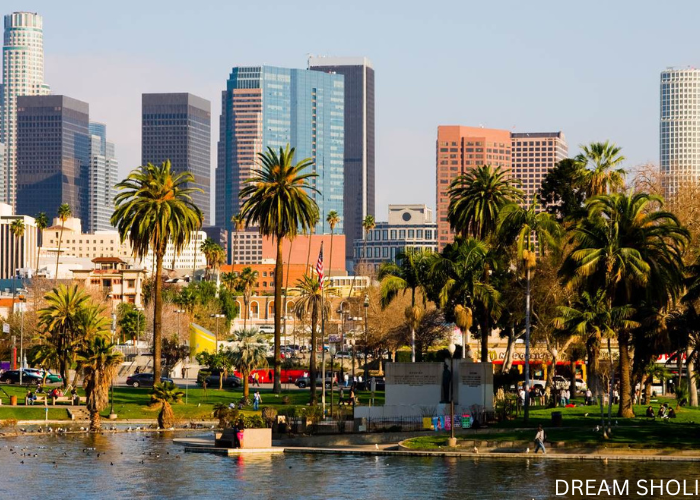
North America is home to the United States, a federal republic composed of 50 states, Washington, D.C. (a federal district), and several territories. The United States is celebrated for its diverse landscapes, rich cultural heritage, and significant influence on global politics, business, and society. As a highly developed nation, it boasts a multifaceted economy driven by key sectors such as technology, finance, healthcare, and entertainment, making it one of the largest economies in the world and a major global power. The population of the United States is marked by its remarkable diversity, comprising individuals from various ethnic, religious, and cultural backgrounds. While English is the predominant language, the nation’s extensive immigrant population has contributed to a multitude of languages spoken across its communities. The U.S. government operates under a democratic framework divided into three branches: the judiciary, the legislature, and the executive. The President, elected by the electorate every four years, serves as both the head of state and government. Overall, the United States presents a complex narrative shaped by its historical journey, diverse populace, and considerable impact on a wide range of social issues globally.
The United States boasts a remarkably diverse climate that varies significantly across its vast expanse. Along the West Coast, particularly in California, residents enjoy an abundance of sunshine and warm temperatures, making it a popular destination for outdoor activities and a vibrant lifestyle. As one travels eastward, the weather patterns become increasingly varied. The South, for instance, often experiences high humidity and sweltering temperatures in the summer, creating a subtropical environment that influences local culture and cuisine. In contrast, the Midwest is characterized by its extremes, with hot summers and bitterly cold winters, which can lead to significant snowfall and icy conditions during the colder months. The Northeast presents a different climate experience, offering mild summers and frigid winters, often accompanied by beautiful fall foliage and winter snowstorms that transform the landscape into a winter wonderland. Overall, the weather in the United States can change dramatically depending on the region and the season. Spring and fall are generally considered the best times to travel across the country, as temperatures tend to be mild and pleasant, making outdoor exploration enjoyable. During summer, certain regions, particularly in the Midwest and South, can become hot and muggy, with heatwaves prompting advisories. Conversely, winter brings frigid temperatures and snow to northern states, creating ideal conditions for winter sports but also challenges for travel and daily life. This climate diversity not only shapes the lifestyle and activities of residents but also influences agricultural practices, natural ecosystems, and regional festivities, showcasing the unique character of each part of the country throughout the year.

The United States is a diverse nation with a rich culinary heritage and a storied past, where each region boasts its own unique flavors and food traditions. In the Northeast, you can savor seafood specialties like lobster rolls and clam chowder, while the South is renowned for its soul food classics, including fried chicken and collard greens. The Southwest offers a vibrant Tex-Mex cuisine, featuring delicious dishes such as tacos and enchiladas. American culture is a dynamic tapestry woven from a multitude of global influences, encompassing everything from Hollywood films and Broadway productions to the rhythms of jazz and blues music. The nation celebrates its diversity by highlighting the richness of its cultural legacy through a wide array of festivals, art exhibitions, and cultural events, showcasing the myriad traditions and artistic expressions that contribute to its unique identity.
States/Cities in America are often the result of an era rather than a specific place, more so than small towns or rural areas. Some of the major countries with large Airports are as follow.
New York, often referred to as New York City (NYC) to distinguish it from New York State, is the most populous state in the United States. Nestled on one of the largest natural harbors in the world at the southernmost tip of New York State, the city is composed of five boroughs, each corresponding to a distinct county. Renowned as a global hub for international diplomacy, New York City plays a pivotal role in various sectors, including academia, science, international banking, commerce, culture, technology, entertainment, media, and fashion. It is also home to the United Nations headquarters.
As the nation’s capital of diversity and opportunity, NYC is the most densely populated major city in the United States, with an estimated population of 8,258,035 residents. The city is a major air travel nexus, boasting one of the busiest air travel corridors in the world. The New York metropolitan area is served by three primary airports: John F. Kennedy International Airport, Newark Liberty International Airport, and LaGuardia Airport. Collectively, these airports accommodate approximately 127.9 million passengers annually. Notably, JFK and Newark Liberty rank as the busiest and fourth-busiest U.S. gateways for international flights, underscoring New York City’s significance as a global travel and commerce destination.


Miami, Florida, is a vibrant metropolis renowned for its stunning beaches, lively culture, and mouthwatering cuisine. The city boasts a rich tapestry of neighborhoods, each offering its own unique charm and experience. For example, Little Havana immerses visitors in Cuban culture with its colorful murals, authentic restaurants, and lively street life, while Wynwood is famous for its artistic flair, particularly at the Wynwood Walls—an outdoor gallery showcasing spectacular street art created by both local and international artists. Miami’s nightlife is equally enticing, with a plethora of clubs and bars that pulse with energy until the early hours, providing the perfect backdrop for a memorable evening. The city’s historic district features striking Art Deco architecture that adds to its distinctive character, and South Beach invites relaxation with its beautiful sandy shores and turquoise waters, making it a favourite spot for sunbathing and socializing.
The primary airport serving Miami is Miami International Airport (MIA), a major hub for both domestic and international travel. MIA connects passengers to a wide array of destinations around the world, reflecting the city’s role as a global gateway. The airport is equipped with numerous amenities to enhance the travel experience, including a variety of dining options that feature both local flavors and international cuisine, as well as shopping outlets offering everything from souvenirs to luxury items. Transportation to and from the city is easily accessible, making it convenient for travelers. Given its bustling nature and efficient operations, Miami International Airport is likely to be a key point of entry or departure for anyone visiting Miami, ensuring that travelers enjoy a seamless journey into this dynamic city.
Chicago, a vibrant city in Illinois, is renowned for its delicious deep-dish pizza, stunning architecture, and lively cultural scene. This dynamic metropolis is home to iconic landmarks such as Navy Pier, Millennium Park, and the Willis Tower, each offering unique attractions and experiences. As you explore the city, be sure to take in the breathtaking views of Lake Michigan and immerse yourself in the diverse neighborhoods, each boasting its own distinct character and charm. Often referred to as the “Windy City,” Chicago is served by two major airports: O’Hare International Airport (ORD) and Midway International Airport (MDW). O’Hare is one of the busiest airports in the world, known for its extensive network of domestic and international flights, connecting travelers to destinations across the globe. On the other hand, Midway Airport, located closer to downtown Chicago, is favored for its convenience and ease of access, making it a popular choice for travelers heading to or from the heart of the city.
Both airports play a crucial role in Chicago’s transportation infrastructure, providing a range of flight options that facilitate travel for millions of passengers each year. Whether you’re arriving in Chicago for business, leisure, or to savor its culinary delights, you’re likely to find yourself using one of these airports. With their comprehensive flight services and proximity to the city, O’Hare and Midway ensure that visitors can easily access all that Chicago has to offer.


San Francisco, California, is a vibrant city celebrated for its diverse neighborhoods, steep hills, and the iconic Golden Gate Bridge. Known for its stunning coastal views and cultural richness, San Francisco offers a culinary haven, particularly famous for its fresh seafood and the bustling atmosphere of Fisherman’s Wharf. Visitors should not miss a trip to Alcatraz Island, the infamous former prison that has transformed into a captivating tourist attraction, providing insights into its intriguing history. The primary airport serving the San Francisco Bay Area is San Francisco International Airport (SFO), a major hub for both domestic and international flights. SFO connects travelers to a wide array of destinations around the globe, making it an essential gateway for those traveling to and from the city.
With its state-of-the-art facilities, SFO boasts a variety of amenities, including numerous dining options featuring local and international cuisine, shopping outlets offering everything from souvenirs to luxury goods, and even an aviation museum showcasing the history of flight. Given its comprehensive services and proximity to the city, it’s highly likely that travelers will pass through SFO when visiting San Francisco, ensuring a convenient and enjoyable airport experience.

Explore the world effortlessly with our tailored travel packages. Let us handle the details while you create unforgettable memories.
Copyright 2024 Dream Sholi